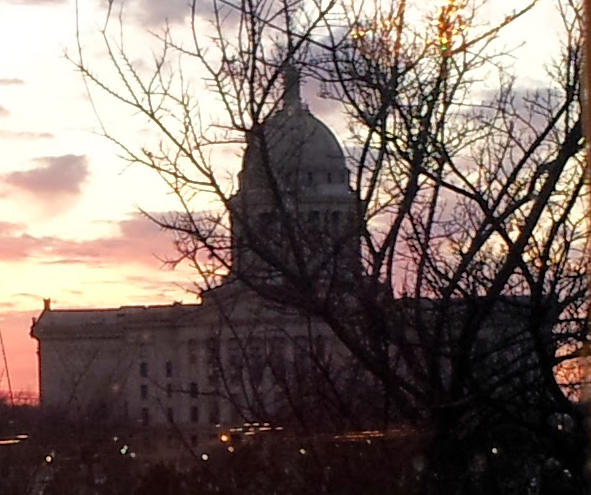Appellate Court Judges Up for Retention
Unlike district judges and other judges in the state who are elected, these 26 higher court judges are appointed by the governor from a list chosen by the state Judicial Nominating Commission (JNC). This 15 member board includes six members appointed by the governor, six selected by the Oklahoma Bar Association, one named by the Speaker of the House, and one by the Senate Pro Tempore. The final slot is selected at large by the commission members themselves. Commission members serve six-year terms, staggered at two-year intervals. Members-at-large serve for terms of two years. No member is eligible to serve immediately after completing a term on the commission.
The argument for this system is that this group can closely examine the judicial qualifications of the applicants better than the general public. After screening and interviewing applicants, the commission recommends three candidates for the governor to choose from to fill vacant positions on the higher courts and also some vacancies when they occur on the lower courts. If the governor does not like any of the nominees, the governor can only ask the commission to submit a new list of nominees. While the judges are appointed for life, the judges of each court must stand for reelection on six-year terms, which are staggered so that some portion of the state’s appellate judges face retention in every even-numbered year. Because their elections are not competitive, Oklahoma’s Code of Judicial Conduct does not allow appellate judges to raise campaign funds or establish campaign committees to support their retention.
In the over 50 years that this system has been in effect, no judge has ever lost a retention ballot election.
When the Oklahoma Constitution was adopted in 1907, all judges were chosen through partisan elections. Then, in 1965, a bribery scandal involving three Oklahoma Supreme Court justices was revealed. In 1967, these justices were impeached, or resigned from office, after investigations determined the justices had accepted bribes in exchange for making favorable decisions in cases.
In 1940, Missouri became the first state to adopt the assisted appointment method and it has since been known as the “Missouri Plan.” Oklahoma became the seventh state to adopt the Missouri Plan which was being pushed by progressives in both major political parties, the League of Women Voters, and the American Bar Association. On July 11, 1967, Oklahoma voters approved State Question 447 in the primary election by narrow margin. This ballot measure amended the Oklahoma Constitution by adding Article 7B which established the current system. In 1987, the process was expanded to include the Oklahoma Court of Civil Appeals. And, in 2010 changes were made concerning the membership of the commission.
Presently, the Oklahoma Supreme Court is made up of nine justices, one of which was chosen by Gov. Frank Keating, two were picked by Gov. Mary Fallin, with one selected by Gov. George Nigh, and five, or a majority, chosen by Gov. Brad Henry. In other words, six of the sitting judges of the Supreme Court were chosen by Democrat governors, with only three picked by Republican governors. Since 1995, while Republicans have held the Governor’s Mansion twice as many years as the Democrats, the Democrats have selected twice as many justices as the Republicans.
Most voters have paid little attention to the Oklahoma Supreme Court (not surprising since they have no say on who gets on it), but in recent years, the liberal slant of this court has become more obvious, with some of their recent decisions. For example, the court voted to throw out an initiative petition to overturn the largest tax increase in state history, and not allow the voters to make a decision on it. They did not like the language of the petition.
Who is up for retention on November 6?
On the Supreme Court, four of the nine justices are up for retention this year. Justice Yvonne Kauger, 81, was tapped by Governor George P. Nigh in 1984. James E. Edmondson, 73, brother of liberal Democrat gubernatorial candidate Drew Edmondson, was appointed by liberal Democrat Brad Henry in 2003. Noma D. Gurich, 66, was named by Governor Henry in 2011. Finally, Patrick Wyrick, 37, was appointed by Mary Fallin in 2017. Wyrick is one of the judges President Donald Trump has on his list of 25 potential nominees to the Supreme Court of the United States. He is presently awaiting confirmation to a seat on the U.S. District for the Western District of Oklahoma, located in Oklahoma City.
The Oklahoma Court of Criminal Appeals is the highest court in Oklahoma for criminal cases, and three of the five justices are up for retention. David B. Lewis was chosen by Henry in 2005. Dana Kuehn and Scott Rowland were both appointed by Fallin in 2017.
On the Court of Civil Appeals, which hears appeals from district courts in civil cases, five of its twelve justices are up for retention. Kenneth Buettner was appointed by Keating in 1996. E. Bay Mitchell was a selection of Governor Frank Keating in 2002. Robert “Bobby” Bell was put on the court by Henry in 2005. Judge Brian Jack Goree was appointed by Fallin in 2012. Finally, Barbara Green Swinton was a selection of Fallin in 2016.
If voters desire the next governor to choose replacements for these judges (from a list put forward by the JNC), then they must vote against their retention. Of course, voters will not know who the next governor is going to be until after they vote on the retention ballot.
A conservative could decide to retain the Republican nominees, on the assumption they are more conservative (perhaps a debatable proposition) and vote against the retention of all the judges who were put onto the bench by a Democrat, on the assumption that they are not conservative (a pretty safe assumption).
A better choice for the future would be to replace the present system with one in which the voters choose the judges at the ballot box, or at least through Senate confirmation. But that will not be on the ballot in November.










Latest Commentary
Thursday 30th of October 2025
Thursday 30th of October 2025
Thursday 30th of October 2025
Thursday 30th of October 2025
Thursday 30th of October 2025
Thursday 30th of October 2025
Thursday 30th of October 2025
Thursday 30th of October 2025
Thursday 30th of October 2025